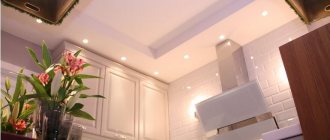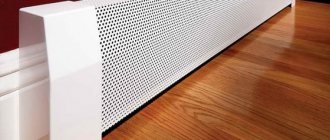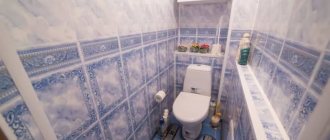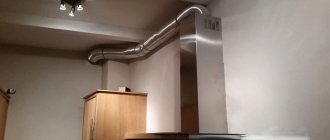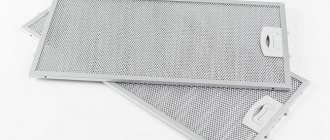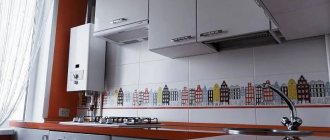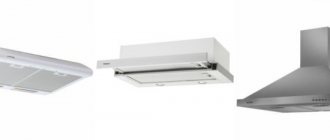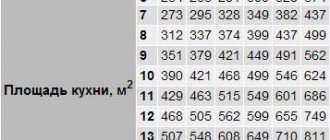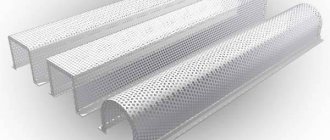The efficiency of the ventilation system of an apartment or private house primarily depends on the correct design of the circuit, the choice of channel parameters and qualified assembly. Therefore, planning of ventilation systems is entrusted to specialists or carried out independently after studying all the rules and requirements of SNiP.
As a rule, customers are left to choose the material and appearance - they can use metal or special plastic boxes for ventilation. In any case, you also need to skillfully choose the shape and type of ventilation ducts.
Materials for choosing boxes for the kitchen, advantages and disadvantages
Decorative boxes that hide the elements of the ventilation system not only perform a decorative function, but also reduce the noise of the hood electric motor
It is important what material the box is made of
It must be resistant to moisture, temperature changes, and not subject to chemical and mechanical stress during cooking.
A box made of any material must be regularly cleaned of dust, grease and dirt. The materials from which boxes are made have their pros and cons.
Therefore, when purchasing or making your own, you need to take this into account. The structures are made from the following materials: plastic, metal, wood and plasterboard.
Plastic construction
Plastic is polyvinyl chloride. Plastic boxes have a round and rectangular shape. The rectangular box is more organic and looks good with the kitchen cabinets.
Quick and easy to assemble. The material has great sound insulation, is durable and has a long service life, and is not subject to corrosion. Easy to cut and adjust to fit. It is very light in weight.
The disadvantages of plastic include the fact that the white color becomes yellow, matte, or gray over time. Forms dents under the weight of objects or from mechanical impact.
After some time, its surface becomes porous, where dust and dirt penetrate, which is difficult to remove. When assembling connections of plastic elements, you must follow the sequence.
To ensure tightness, so that dirty air does not fall on the surface of the box and penetrate into the room, silicone should be applied to the joints. There are many different connecting parts available for sale.
With their help, channels are connected in any direction and at any angle. The fasteners of the structure must be placed often along the entire length at a distance of at least a meter, and also strengthened at the junction of parts with each other.
Metal construction
A metal box or hood is a more reliable design. Stainless steel is the ideal starting material. Ordinary metal is coated with powder-based paint.
Stainless steel is easy to clean, does not absorb dirt, is strong and durable. Features a stylish modern design. There are no visible scratches on it. The material is not subject to corrosion.
The disadvantages include the high price and the presence of a monotonous range of colors. Complexity of assembly, the need to maintain accurate measurements. The design is heavy and requires reliable fastening.
A box made of this material does not protect against noise, and fingerprints remain on the surface, which are difficult to erase. It does not always fit into the interior of the furniture and looks bulky.
When assembling a metal frame, welding is used and cut with a grinder. If the metal sheet is thin, replace welding with metal glue. The sheets are overlapped.
Plasterboard structures
A cheap, lightweight material - drywall is easy to assemble in any configuration and shape. It is necessary to install metal profiles for installation.
Allows you to assemble a box to hide the air duct in a short time
When working with drywall, care must be taken as the material is quite fragile.
The material is convenient and easy to process, so the box can be made and assembled by yourself, without unnecessary expenses or the involvement of a craftsman. The finished box can be processed, puttied and finished with tiles, wallpaper, mosaics and other decorative materials.
With proper use and pre-treatment against impacts, it will last a long time.
Decorative wood box
A wooden box looks harmonious with a kitchen set made of the same material. Possessing the same properties, it will be part of the kitchen, complementing the design of a certain style, and also fulfilling a functional purpose.
Wood is an environmentally friendly, reliable, good material that requires little maintenance. The disadvantage is the heaviness of the finished structure.
Recommendations for selection
Experienced specialists give a number of tips to make it easier for owners to choose products for arranging a ventilation system. Some of them:
- It is best to buy products in branded stores or specialized retail outlets.
- In addition to the product, the kit should contain instructions for use, as well as a warranty card. If such documentation is missing, it is better to refuse the purchase.
- It is necessary to take into account the design of the products so that they fit organically into the interior of the room.
- The manufacturer is of no small importance. It is advisable to choose high-quality branded models.
- No need to focus on low prices. Of course, a high-quality and reliable ventilation system will be quite expensive, especially if good materials are used. However, you need to understand that high-quality models will serve for many years without complaints.
- Products must have sufficient performance. If the ventilation system is weak, the hood will not be able to cope well with its main task, so the exhaust air masses will remain in the room.
We recommend that you read: Organization of natural and forced ventilation in the kitchen
In addition, when choosing the components of the ventilation system, you need to take into account the main functions of the kitchen hood. The latter must meet the following characteristics:
- An attractive appearance is important so that the device fits organically into the interior, complementing it.
- Low noise level during operation.
- The ability to quickly and to the required extent remove foreign odors.
Used as a decorative element
The principle of the method is decoration. This applies not only to the ventilation duct itself, but also to the adjacent part of the wall (in some cases). You need to make sure that the box becomes a stylish accessory to the interior of the room. The following techniques are used for this:
- Fixing the mirror will not only have a functional purpose, but can also visually expand the space.
- Sticker of wallpaper, photo wallpaper, panels. Any of the options suits the style of the room.
- Continue finishing the work apron. It could be tiles, porcelain tiles, mosaics, melamine surfaces or something else. The goal is to blend the ventilation duct with the rest of the kitchen.
- Assembling a frame from gypsum board allows you to change the configuration of the box and give it the desired shape.
- A similar situation applies to cladding with PVC and MDF panels. The sub-cladding system covers visible imperfections.
- Organization of the slate board. Simple and tasteful, it will be possible to leave messages and wishes for household members, and write down important reminders.
- Decoration with artistic painting is suitable for rooms that already have such decorative techniques. You can emphasize the decorative significance of the ventilation duct by highlighting it with lighting. The ideal option would be spotlights recessed into the ceiling or a diode strip located there.
An example of the correct layout of a kitchen space Source stosastudio.ru
Extremely inconvenient location of the ventilation shaft Source esen.ucoz.net
Selection of material
Once the dimensions have been calculated, you need to decide on the material for the hood decorator. You should not save on purchasing high-quality material, since this box is designed to last for several years. It will be exposed to various influences: sunlight, temperature changes, chemical treatments, shocks, etc. It’s worth taking care of this in advance; you’ll spend less nerves, effort and money.
The material for decorating the exhaust system, as a rule, matches the material of the installed kitchen unit. The most commonly used materials are plastic, wood, plasterboard, and metal.
Due to its flexibility, a PVC box product can be manufactured in any shape (round, square, triangular, rectangular). It can be easily combined with a stretch ceiling or decorative wallpaper. The negative side of a plastic box is its high price.
A wooden box is not durable in use and causes difficulties in cleaning. The settling dust must be removed more often, otherwise it will penetrate into the top layer of the tree. When impacted, a wooden product is quite durable, but is not always resistant to chemical reactions. In addition, wood is not a flexible material, so the design will be either square or rectangular.
Since this material is readily available, you can use an old wardrobe or bedside table as structural parts. This will significantly reduce your costs.
- A plasterboard box is used very often, as this material has many advantages. For example: low cost on the market; You can use used material; easy to assemble and install; small weight category. The material is durable, strong, and relatively flexible. With its help, you can elegantly hide the shortcomings of a corrugated air duct.
- Metal decor for hoods has its positive and negative sides. The box, made of stainless steel (steel, aluminum), is very strong and durable, which allows it to be used for many years. The metal is coated with a special polymer composition, or paint, which allows you to care for it without much effort. This is a flexible material that will allow the kitchen owner to fantasize and experiment endlessly.
Negative aspects - the iron box is difficult to install; it does not absorb noise, but amplifies it; expensive in price and heavy in weight. As a rule, metal structures are used in industrial and specialized kitchen areas.
7 photos
Round ducts
With a comparable cross-sectional area, round air ducts take up more space in height than rectangular ones, but if the building height of the object allows, then it is better to use air ducts with a round cross-section. Less noise, less resistance and the entire ventilation system will be more energy efficient. This is important to reduce operating costs and also initial capital costs (smaller fan sizes).
You can also add the interior to the requirements for choosing a ventilation system. And this criterion can be decisive in choosing the cross-section of the air duct.
After all, to hide a round air duct, much more space is needed, which may require changing the design of the room, which is not always acceptable. This is not to mention placing them outside, which will completely ruin the appearance of the building. In this case, rectangular air ducts will help you.
Source
Review of air ducts for kitchen hoods
To connect the exhaust outlet pipe to the opening of the vertical shaft, 3 types of boxes are used:
- flexible aluminum corrugation of the Aluvent type;
- PVC plastic channels of round and rectangular cross-section;
- metal boxes of various shapes.
Now we will analyze each group of kitchen exhaust ducts separately - we will list the characteristics, pros and cons of the products.
Aluminum corrugated pipes
The flexible channel is a frame made of soft wire, covered with thin aluminum foil. A layer of polyester is applied on top for better sealing. The pipeline is transported and sold in a compressed state, after unpacking it is stretched to the required length (maximum 5 times).
Air duct technical characteristics:
- wall thickness – up to 100 microns, cross-section – round;
- maximum operating temperature – 250 °C;
- permissible bending radius is 0.7D (D – diameter);
- range of diameters: 80, 100, 110, 120, 125, 130, 140, 150 mm.
The main advantage of aluminum hoses is their reasonable price; 1 meter of air duct Ø100 mm in stretched form costs approximately 50 rubles. (0.9 cu). Thanks to a rich range of standard sizes, the ventilation duct can be easily matched to the outlet diameter of the hood opening and ventilation grille.
The corrugated exhaust duct is installed quickly and easily. The pipe is stretched to the required length, one end is put on the fitting of the exhaust unit, the other - on the grille. Then the corrugation is fixed with ordinary clamps, and the installation ends here.
The flexible corrugated pipe can be installed in literally 5 minutes; just secure the ends with clamps
Disadvantages of flexible channels:
- The appearance of aluminum corrugation does not meet modern interior design requirements. The box is suitable for a hood in a country house, in a summer kitchen or in an apartment undergoing regular renovation. In other cases, the pipe must be hidden behind a decorative casing or plasterboard sheathing.
- The wavy structure of the walls creates increased resistance to air flow. Fan efficiency decreases.
- For the same reason, more fat deposits are retained inside the canal. It is impossible to clean the corrugation; it is easier to replace it.
- Aluminum foil is easily damaged by any sharp object.
The last negative point is that when the hood is operating, the corrugated pipe makes a lot of noise. The reason is the vibration of thin flexible walls plus a wavy profile that provides air resistance.
In short sections, corrugated pipes look satisfactory; in longer channels, all beauty is lost
Plastic ventilation ducts
White polyvinyl chloride (PVC) is used to make air ducts. The pipeline does not bend, so sections of the ventilation network are connected using shaped elements - couplings, nipples, elbows, tees and various adapters. Characteristics of plastic boxes:
- maximum temperature of the transported medium – 200 degrees;
- cross-sectional shape – round, rectangular (flat);
- Diameters of round ducts suitable for hoods are 100, 125, 150 mm;
- “running” dimensions of flat boxes – 55x110, 60x112, 60x204, 90x220 mm;
- the length of the standard section is from 35 cm to 2 m.
Plastic air ducts are connected to fittings in two ways:
- The round section is put on the outside of the mating part of the mounting element - bend, tee or nipple.
- Rectangular pipes, on the contrary, are inserted inside the fittings. Couplings are used to connect straight sections.
On the left in the diagram the nipple connection of a round PVC air duct is shown; on the right, rectangular sections of ventilation ducts are inserted into the tee couplings
In both cases, the joint is carefully sealed with silicone compound. The cross-sectional shape of the ventilation duct can be changed at any point - install a straight or angled adapter, use a tee with different terminals.
The price of plastic is noticeably higher than corrugations of the same diameter. A meter of pipe Ø100 mm will cost about 180 rubles. (3.15 cu), rectangular box of equivalent section 110 x 55 mm - 185 rub. (3.3 USD). Here we also need to add the cost of the shaped parts involved in the scheme.
Other disadvantages of plastic ventilation ducts:
- the color range is limited to light shades, black pipes are impossible to find;
- Accordingly, dust and other pollutants are clearly visible on the air duct;
- plastic is afraid of overheating above 200 °C and is capable of burning on its own;
- over the years, polyvinyl chloride turns yellow and loses its appearance;
- the walls of flat boxes bend at the joints, a gap 1-4 mm wide is formed, as shown in the photo.
Choosing an air duct: round or rectangular
Construction technologies make it possible to create airtight buildings to reduce heat loss and optimize operating costs, so the question of whether or not to have a ventilation system is no longer discussed. Fresh and clean air is necessary for the health and productivity of people, and the performance of equipment.
Ventilation and air conditioning systems, regardless of type (central or local), have channels for organizing air exchange: supplying clean air and removing polluted air. In 90% of cases, ventilation ducts made of galvanized steel are used for general ventilation; less often, plastic or fabric air ducts are used.
The decision about which air duct to install for a specific project or facility is made by the designer, guided by building codes and SNiPs.
The choice of cross-sectional shapes is not large, but I will decide on a round or rectangular cross-section for air ducts and there is something to think about.
Plastic box ↑
There are round, square and rectangular plastic boxes for hoods. The choice of design largely depends on the shape of the ventilation hole, but it should be noted that flat boxes, which are so easily hidden behind furniture or in the corner of a room, are usually designed for low-power appliances. But pipes with a round and square cross-section can handle a large volume of air, but they are no easier to disguise than flexible corrugation (although in any case, the plastic structure looks more aesthetically pleasing).
A plastic hood can serve as both an air duct and a decoration. It looks good without additional finishing due to its laconic appearance, but if necessary, it can be painted to match the color of the walls or furniture. The rectangular structure can be laid directly on top of the kitchen unit, without resorting to special disguise tricks.
The flat plastic box hides easily on furniture
Advantages of plastic boxes:
- Low noise level - the low conductivity of the material significantly reduces the sound effect from a working hood. The box practically does not resonate with air flows also due to its fairly rigid design.
- Long service life - this material does not corrode, tolerates moisture well and prevents the accumulation of condensation.
- Hygiene - virtually no vapors of fats and other suspended particles, which are quite abundant in the exhaust air, are deposited on the inner surface of the plastic. This means that you won’t have to try on the role of a “chimney sweep” very often.
- Quick installation - thanks to its low weight, plastic is easy to work with.
- Easy care - just periodically wipe the plastic from dust with a damp cloth.
The main disadvantages of plastic are mainly aesthetic: over time, a white box can turn yellow or gray, and a colored box can fade when exposed to sunlight. But if the air duct is installed correctly and hidden behind the canopy of the furniture, this does not matter much.
A plastic box for a kitchen hood is easy to assemble with your own hands. It is mounted according to the “socket-pipe” principle. A large assortment of connecting connections and elements of various lengths allows you to install the structure even in a room where there are many corners and other obstacles. If necessary, fitting the pipes can be done manually - the plastic can be easily sawed with a regular hacksaw.
Elements of a plastic box
To assemble plastic boxes for kitchen hoods, you can buy the following auxiliary elements in addition to the main pipes:
- “Elbow” is a rectangular or round part for bending the air duct. With its help, you can rotate the box 45 or 90 degrees.
- Adapters - allow you to create combined structures in which both round and rectangular pipes are used simultaneously (for example, a more powerful air duct from a pipe with a round cross-section emerges from the hood, which turns into a laconic rectangular duct near the wall or ceiling).
- Connectors - if the length of one pipe is not enough to connect to the ventilation hole, you have to extend the air duct using another piece of pipe and an adapter. Of course, the connector must match the cross-section and shape of the parts.
- Anti-return valve - ensures air movement only towards the outlet. If a reverse draft is triggered in the ventilation duct (for example, during strong winds or when a powerful hood is running in a neighboring apartment), the valve closes the entrance to the shaft and blocks the penetration of unpleasant odors.
- The grille is fixed at the very entrance to the shaft and provides a hole of the required cross-section where the ventilation duct for the kitchen hood is inserted
Using these elements, you can assemble a structure of any length. The main thing is to fasten the connections sequentially, not forgetting that the air through the hood should only move in one direction.
Example of a plastic box design
Plastic hood box: advantages and important installation points
Any kitchen is complete only when it is equipped with all the necessary appliances and systems.
A kitchen hood removes odors, drops of fat and oil from the air in the room. But the air duct is responsible for their further removal into the ventilation shaft. It would seem that this is an insignificant and unworthy detail, but in reality it is not so. It’s not for nothing that there are different types of such systems, for example, a plastic hood box is just as popular as, for example, a corrugated model or a metal one. And even somewhat superior to them in this matter. Today in the article we will find out how it compares favorably with its “relatives” and show what is included in its kit. We will also find out two important points that should be taken into account when installing it.
How to choose?
The choice of hood box depends on the following criteria:
- operating features - temperature, humidity, dustiness of the room, mechanical influences;
- maximum permissible load on supporting structures;
- ventilation equipment capacity;
- requirements for vibration and noise insulation.
When choosing an air duct, you must follow the following recommendations:
- the number of joints should be minimal;
- you should reduce the number of structural elements when creating a wiring plan and at the same time maintain the system parameters;
- To reduce the number of blockages, flow resistance, noise and vibrations, channel turns should be kept to a minimum.
Kitchen hood box
Rules for choosing the duct cross-section
The cross-section of the air ducts is selected depending on the exhaust power, maximum air throughput, regulatory requirements for installation and operation. Usually the size is taken equal to the area of the hood inlet pipe or slightly larger. If ventilation is rarely used, the cross-section relative to the pipe may be reduced.
The cross-sectional area Sc (cm2) is calculated using the formula:
S_c=L×k/V,
where L is air flow in m3/hour;
V is the speed of air movement in the ventilation system m/sec;
k is the coefficient of dimensional coordination; in these units of measurement it is equal to 2.778.
The actual cross-section S (cm2) of a circular shape can be determined as follows:
S=(π·D^2)/400,
where D is the pipe diameter in cm2.
For rectangular air ducts, the actual cross-section is determined by the following formula:
S=(A B)/100,
where A is the channel width in mm, and B is the length, mm.
Manufacturers and models of ready-made solutions: ratings and prices
The rating of exhaust systems is as follows:
- in the budget class worth up to 10 thousand rubles: Siarko, Faber, Korting, Kuppersberg;
- in the middle class up to 50 thousand rubles: Miele, Siemens, Smeg, Teka;
- in the elite class from 50 thousand rubles: Electrolux, Falmec, Bauknecht.
TOP 5 manufacturers of hoods: Hansa, Gorenje, Samsung, Elikor, Bosh.
Functionality of telescopic hoods
In order not to irritate the owner’s ears with constant operation, such a device must operate silently, and its performance must be impeccable. Therefore, when choosing a specific model for the kitchen, it is important to consider its mounting location, installation features, and compatibility with the overall interior of the room. If the kitchen area is insufficient, choose a compact device: its dimensions do not in any way affect the efficiency of work. A telescopic kitchen hood is best suited for this.
The ease of use of a telescopic kitchen hood is perfect both in limited space and in kitchens of any size. The operating efficiency of the unit is equal to 1000 cubic meters. m is considered maximum.
To determine the power of the hood, pay attention to the motor installed inside. Thus, the turbine will show the best results, while at the same time, single- and double-engine units perform their functions well.
But when choosing such kitchen pull-out models, you need to be prepared for the fact that powerful devices will be noisier.
As reviews from many consumers show, such hoods are especially convenient and comfortable. They are more compact compared to similar equipment. The panel, which smoothly slides out of its body, quickly retracts into its usual position, without interfering at all with the preparation of dishes. You cannot hit your head on the body of the telescopic hood: it is always in the right place, at a safe distance.
The most convenient and interesting option today are stainless steel hoods; they harmonize perfectly with the sink and hob. Most often they have light shades - white, beige, gray, their width is 50–60 cm. The correlation between the sizes of the stove and the hood should be as follows: the device is installed above a hob with a smaller width, but not vice versa. This way the device will work much more efficiently.
Features of installing an air duct for a kitchen hood
The task of a kitchen hood is to create an outflow of exhaust air without disrupting natural ventilation. Before installing plastic air ducts, the unit must be secured to the wall or ceiling.
For kitchen exhaust ducts, 2 types of products are used:
- PVC pipe;
- household corrugation made of aluminum.
Shaped elements and fastening to walls and ceilings
The most common segments on sale are 0.5-1 m long. When installing a plastic air duct for a kitchen hood, they are connected along the length using couplings.
To narrow them, adapters are used, but it is not recommended to change the cross-section unless necessary. Pressure losses increase and noise increases several times.
To change direction, use your knees. A sharp 90° turn can be rounded by connecting two plastic 45° exhaust elbows.
Communication will look much neater if you convert the round plastic ventilation duct into a flat one. This is done using a special adapter. Then you can run the channel close to the wall.
To maintain natural ventilation in the kitchen, a grille with 2 holes is installed on the shaft - one for connecting the air duct, the other for passing air into the exhaust shaft. Such products have an injector - a special partition to cut off the reverse flow.
To attach round and flat plastic air ducts to a wall or ceiling, manufacturers produce special holders that match the standard sizes of the ducts. The product is inserted into the fastener and snapped into place. Aluminum hangers, which are used for mounting drywall, clamps with a pin and a rubber gasket, and metal mounting tape, are also suitable.
Assembly Features
The easiest way to install aluminum corrugation. For assembly you will need two clamps and a grille for the ventilation shaft.
One end of the flexible air duct is placed on the adapter flange of the hood, the other is attached to the grille. The joints are secured with clamps, and that’s it - the corrugation is installed.
Typical hoods are usually equipped with a decorative casing. Before installation, it is removed and then installed in place.
Plastic parts are easy to cut. They are cut after measuring the size of the ventilation branch, using a hacksaw. The elements are connected in series into a spatial structure. During assembly, the joints are coated with silicone sealant.
When connecting a plastic hood in the kitchen, you can install a return valve at the end of the air duct, which prevents the reverse flow of air.
If you plan to install a suspended or suspended ceiling in the kitchen, and the hood will be attached to the ceiling, pre-install the embedded parts. Tension the canvas only after installing and connecting the duct to the ventilation shaft.
Plastic air ducts are used in everyday life and in production. For high-quality air exchange, you need to choose the right cross-section. In the kitchen, it is optimal to use plastic ventilation pipes for hoods with smooth walls. They make less noise, do not accumulate dust, and do not interfere with air flow.
Connection rules and errors when installing air ducts for a kitchen hood on video:
262
Installation of the frame for the hood
There are three horizontal lines on the walls, one long and two short. A 28x27 mm guide profile is attached to the wall along them. It is most convenient to make a V-shaped cutout on the guide in order to bend it at a right angle and place the profile in the corner between the walls. You can do the same with the second corner. Or you can attach short profiles simply by cutting them to the required length, whichever is more convenient for you.
Holes are drilled in the profile and wall in increments of 60 cm
Since the load-bearing wall often ends up in the kitchen, you will need a hammer drill for the job. The profiles are attached to the wall using driven dowels (at least two per profile).
A sealing tape can be laid between the profile and the wall. It will reduce vibrations and provide good additional sound insulation.
On the ceiling we repeat all the steps that were done with the wall and also install guides. When assembling a plasterboard box in the kitchen, we will get a frame made of profiles, the parts of which rest against each other at right angles. Next you need to secure the profile, which will be the protruding corner of the frame. There are two ways to do this.
- Cut the jumpers to the same length and lower them from top to bottom. Then attach a guide along the entire length of the wall to them below.
- Attach drywall to the front wall. Lower the jumpers from top to bottom, securing them to the drywall. Then attach the profile to the jumpers.
If you can get by with one profile (the length of the guide exceeds the length of the kitchen), then it is better to insert it, fixing it in the corners. This profile will just fit into the horizontal guides on opposite walls. After this, the inserted profile will need to be secured with small metal screws (2 pieces on each side).
Methods for masking a ventilation duct
Using simple methods, the ventilation will be reliably masked. One way would be to hide it behind pieces of furniture. After installing the cabinets, it will be impossible to guess its presence.
The design of a kitchen with a ventilation duct requires a special approach and a non-standard solution to the problem of an unsuccessful layout.
In a wide kitchen, when there is a corner protruding element, the option of purchasing a furniture set made in the letter G will help. If the protruding support is slight, the box located above the kitchen set will enhance the camouflage.
Functional box cover
There are various ways to transform a ventilation element into a functional item. Make compact shelves on a flat box. They will perform useful tasks: suitable for storing various containers and shallow dishes.
It is better not to disguise, but to increase functionality.
By attaching the bracket to a structure running along the walls, it will serve as a support for the plasma monitor.
A bar counter and an imitation fireplace will make it possible to decorate the kitchen space in an original way. Such a design will simultaneously act as a camouflage and bring comfort, beautifying the house.
You can turn the box into a TV stand.
Ventilation duct as decoration
The protruding part of the ventilation does not have to be hidden; it can be successfully decorated. In this case, you will need ordinary materials. First of all, you need to decide on the desired style. Possible finishing of the box.
Hang a drawing board. To achieve an unusual atmosphere, the box is coated with special slate paint. You will have a plane for writing reminders to your family members.
There is space on it to create a menu.
- Mirror surfaces - cover the box with mirrors and special reflective panels. This will help visually expand the space.
- Mosaic - a finishing material suitable for creating a country, Provence style. You can lay out the entire structure, in the middle, with a metal mosaic, which will create a style for high-tech lovers. A combination of various abstract designs and colorful patterns will add some zest to the setting.
- Modeling an interior that resembles finishing natural stone - covering the surface with tiles that look like brickwork. It is attached using adhesive. If desired, the tiles are laid out along the entire perimeter of the wall, separately on the box. The coating with cement mortar with the effect of unevenness looks original.
- Tile - placing the box flush with the kitchen apron will allow you to cover it with tiles of the same shade, diluted with a color palette. The burgundy shade will add playfulness. It is suitable to use tiles of a uniform style with different image application.
- The column of authenticity is a bold decorative design that allows you to create a Mediterranean style in your apartment.
Textured plaster or stone finishing will help increase the effect.
Types: materials and characteristics
For the installation of small home ventilation systems, the industry produces a wide range of pipes and components.
Air ducts for domestic ventilation are divided into:
- By material - plastic, aluminum or galvanized steel.
- Shape: square, rectangular, round.
- According to the degree of flexibility - flexible or rigid. Flexible boxes are made of corrugated aluminum or galvanized steel. Rigid air ducts made of metal are not used due to the complex installation and complexity of manufacturing galvanized pipes of small sizes (from 100 to 150 mm in diameter or section side length). Aluminum pipes of suitable sizes are expensive, there are no special advantages in their installation, so they are also not used for kitchen hoods.
Plastic
Plastic air ducts are round, square and rectangular with a smooth surface. They come in white and painted in different colors - it’s easy to choose a shade that matches your furniture set or wallpaper.
Plastic boxes are very smooth - they are easy to clean, and less grease and soot accumulate inside. Smooth walls provide the least air resistance - therefore, such pipes vibrate and make less noise. Plastic boxes are the quietest compared to corrugated boxes.
.
Made from flexible corrugated aluminum pipe
A very practical option for an air duct is a corrugated aluminum pipe of round cross-section. The flexible pipe is easy to install; it does not require rotating elements - it can simply be bent. An aluminum pipe is durable, but it is very difficult to clean it from grease and soot deposited on the walls. The corrugated inner surface creates great resistance to air flow; the pipes make more noise when the hood is operating.
Metal
The corrugated pipe can be made of galvanized steel. This pipe is a little stiffer and stronger, but otherwise its installation is as simple as for aluminum corrugation.
Places with a damaged zinc layer rust, the rigidity of the pipe complicates its installation, so steel corrugation is rarely used for internal household ventilation systems.
By degree of flexibility
Aluminum corrugation is more ductile than steel, it is easier to bend, stretch and compress.
Plastic air ducts are used only for rigid ones; corrugated plastic pipes are not suitable for transporting hot air.
Kinds
Air ducts designed for proper operation of the hood are different. They are made from various materials, which always affects their performance characteristics and final cost. Let us consider in detail what types of such units exist, and by what parameters they are divided.
All types of air ducts are mainly divided into rigid and flexible types.
Flexible air ducts can be positioned at a variety of angles. If required, they can be stretched or compressed (of course, within the limits of what is possible). However, it must be taken into account that a weakly elongated air outlet has a stronger resistance to air flow. This does not have the best effect on the overall efficiency of the system as a whole. In most cases, such models are made of aluminum. The main disadvantage of such systems is that it is not recommended to make the corrugated box longer than 3 m, since any extra centimeter in this situation will reduce productivity by about 5-10%.
And also all air ducts are divided according to their immediate shape. There are several options for such systems.
Let us consider in detail what types of air ducts for hoods are.
Rectangular and square. These types of air ducts are recognized as one of the most popular and occur with enviable regularity. Many owners choose them precisely because of their shape, which allows them to be placed directly behind kitchen cabinets. Thanks to this feature, it is possible to lay almost any path from the exhaust equipment to the ventilation shaft. Rectangular specimens will be an excellent solution for kitchens with any ceilings (meaning any height parameter). In addition, these models boast a good appearance.
- Flat. These duct options are one of the varieties of rectangular models. They are very modest in size and seem completely invisible.
- Rounded. Such varieties are more demanding - they can only be installed in rooms with high ceilings. This requirement is due to the large dimensions of the equipment. If the outlet has a rectangular structure, then it will be necessary to additionally use rectangular adapters with the appropriate cross-section for round models.
- Oval. These specimens have the same strengths and weaknesses as the rounded specimens.
Of the listed options for air ducts, flat rectangular models should be highlighted.
They are represented by products with the following parameters:
- 110x55 mm - such options are required for hoods with a capacity of no more than 300 m3/h;
- 120x60 mm – suitable for equipping hoods whose performance level does not exceed 350 m3/h;
- 204x60 mm - ideal for operation in conjunction with high-performance units - up to 1000 m3/h.
Flexible and rigid products
There are many different types of kitchen hood ducts. For example, all products can be classified according to the materials from which they are made. The final cost of the product, as well as its performance characteristics, directly depends on this quality. However, this is far from the only factor by which air ducts are divided.
All types of construction are divided into 2 types:
- Flexible - can be placed at different angles. If necessary, they can be compressed or stretched (of course, within reason). However, it should be borne in mind that a slightly elongated air duct resists air flows much better. This contributes to a decrease in the efficiency of the ventilation system as a whole. Such structures are often made from aluminum. The main disadvantage is that experts do not recommend making a corrugated box longer than 3 m. This is due to the fact that every extra meter will reduce the system’s performance by 10%.
- Rigid structures are characterized by ease of assembly. In addition, the inner surface of such products is smooth and even. The price of these models is much higher, but their positive properties justify the cost.
We recommend that you read: Correct installation of a hood in the kitchen with your own hands
